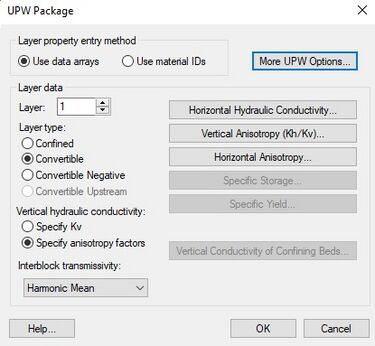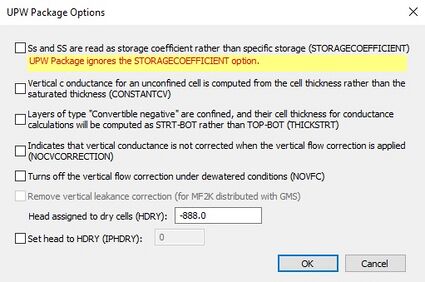GMS:UPW Package: Difference between revisions
From XMS Wiki
Jump to navigationJump to search
No edit summary Tag: Reverted |
No edit summary Tag: Manual revert |
||
| Line 1: | Line 1: | ||
{{MODFLOW Links}} | {{MODFLOW Links}} | ||
The UPW (UPstream Weighting) flow package can only be used in a MODFLOW-NWT model. The UPW flow package is based on the [[GMS:LPF Package|LPF package]] but differs in that the rewetting and vertical conductance correction options are not available. Also, in a simulation including extraction wells with the LPF package, as soon as the cell goes dry the pumping stops, but with the UPW package the pumping continues at a reduced rate because of the different way wetting and drying are handled. By default the UPW package does not assign the HDRY value to cells that go dry unless the IPHDRY variable is turned on. It also differs from the [[GMS:LPF Package|LPF package]] in that it smoothes the horizontal conductance and storage change functions to have a continuous derivatives so they can be solved by the Newton method. Using the UPW package requires using the [[GMS:NWT Package|NWT solver]], though the NWT solver can be used with the LPF package instead. | The UPW (UPstream Weighting) flow package can only be used in a MODFLOW-NWT model. The UPW flow package is based on the [[GMS:LPF Package|LPF package]] but differs in that the rewetting and vertical conductance correction options are not available. Also, in a simulation including extraction wells with the LPF package, as soon as the cell goes dry the pumping stops, but with the UPW package the pumping continues at a reduced rate because of the different way wetting and drying are handled. By default the UPW package does not assign the HDRY value to cells that go dry unless the IPHDRY variable is turned on. It also differs from the [[GMS:LPF Package|LPF package]] in that it smoothes the horizontal conductance and storage change functions to have a continuous derivatives so they can be solved by the Newton method. Using the UPW package requires using the [[GMS:NWT Package|NWT solver]], though the NWT solver can be used with the LPF package instead. | ||
[[File:UPW Package.png|thumb|375 px|The ''UPW Package'' dialog]] | [[File:UPW Package.png|thumb|375 px|The ''UPW Package'' dialog]] | ||

